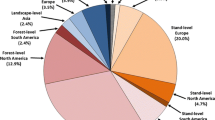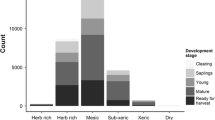Abstract
I present examples of plant functional–structural models (FSMs) that are used to evaluate how foliage units affect whole-canopy functions, and I show that multi-criteria optimization is an effective tool for these models. FSMs produce plant structures through the repeated application of a set of rules for the placement of foliage units. The models are blind (rules are the same regardless of dynamic simulation conditions), sighted (rules change with interference from other foliage units) or self-regulatory (rules change depending on the conditions of the simulation, i.e., internal conditions). In the examples presented, the models are used to optimize plant morphology for one or more measures of plant performance; these measures include movement of materials and associated hydraulic functions, foliage display, light interception and net carbon, mechanical support and stability, and reproductive success. It is consistently found that no morphology is optimal for any single measure of plant performance, and the rules for plant development are not stationary in space and time. In multi-criteria optimization, alternative morphologies are compared against multiple measures of plant performance; these are optimized simultaneously using Pareto optimality, which yields the set of mutually co-dominant solutions not dominated by any other solution. Two solutions are considered to be mutually co-dominant if improvement with respect to one criterion is at the expense of another criterion. I conclude that multi-criteria optimization is an essential tool for the use of FSMs to relate processes at the foliage level to whole-canopy function and to explain the structural diversity of old-growth forests.




Similar content being viewed by others
References
Allen MT, Prusinkiewicz P, DeJong TM (2005) Using L-systems for modeling source-sink interactions, architecture and physiology of growing trees: The L-PEACH model. New Phytol 166(3):869–880
Aono M, Kunii TL (1984) Botanical tree image generation. IEEE Comput Graph Appl 4(5):10–34
Bell AD (1986) The simulation of branching patterns in modular organisms. Philos Trans R Soc Lond Ser B 313(1159):143–159
Borchert R, Honda H (1984) Control of development in the bifurcating branch system of Tabebuia rosea: a computer simulation. Bot Gaz 145(2):184–195
Cohon JL (1978) Multiobjective programming and planning. In: Bellman R (ed) Mathematics science and engineering, vol 140. Academic Press, New York
Esseen PA, Renhorn KE, Pettersson RB (1996) Epiphytic lichen biomass in managed and old-growth boreal forests: effects of branch quality. Ecol Appl 6:228–238
Evers JB, Vos J, Chelle M, Andrieu B, Fournier C, Struik PC (2007) Simulating the effects of localized red: far-red ratio on tillering in spring wheat (Triticum aestivum) using a three-dimensional virtual plant model. New Phytol 176:325–336
Farnsworth KD, Niklas KJ (1995) Theories of optimization, form and function in branching architecture in plants. Funct Ecol 9(3):355–363
Fisher JB, Honda H (1977) Computer simulation of branching pattern and geometry in Terminalia (Combretaceae), a tropical tree. Bot Gaz 138(4):377–384
Fisher JB, Honda H (1979) Branch geometry and effective leaf area: a study of Terminalia-branching pattern.1. Theoretical trees. Am J Bot 66(6):633–644
Ford H (1987) Investigating the ecological and evolutionary significance of plant growth form using stochastic simulation. Ann Bot 59:487–494
Ford ED (ed) (2000) Scientific method for ecological research. Cambridge University Press, Cambridge
Ford R, Ford ED (1990) Structure and basic equations of a simulator for branch growth in the Pinaceae. J Theor Biol 146:1–13
Ford ED, Avery A, Ford R (1990) Simulation of branch growth in the Pinaceae: interactions of morphology, phenology, foliage productivity and the requirement for structural support, on the export of carbon. J Theor Biol 146:15–36
Früh T (1997) Simulation of water flow in the branched tree architecture. Silva Fennica 31(3):275–284
Godin C, Sinoquet H (2005) Functional–structural plant modeling. New Phytol 166(3):705–708
Grier C, Logan R (1977) Old-growth Pseudotsuga menziesii communities of a western Oregon watershed: biomass distribution and production budgets. Ecol Monogr 47:373–400
Grimm V (1999) Ten years of individual-based modelling in ecology: what have we learned and what could we learn in the future? Ecol Model 115:129–148
Hamer TE, Nelson SK (1995) Characteristics of Marbled Murrelet nest trees and nesting stands. In: Ralph CJ, Hunt GL Jr, Raphael M, Piatt JF (eds) Ecology and conservation of the Marbled Murrelet. General Technical Report PSW-GTR-152. USDA Forest Service, Pacific Southwest Research Station. Albany, California, USA, pp 69–82
Hershey KT, Meslow EC, Ramsey FL (1998) Characteristics of forests at spotted owl nest sites in the Pacific Northwest. J Wildl Manage 62(4):1398–1410
Hinckley TM, Sprugel DG, Brooks JR, Brown KJ, Martin TA, Roberts DA, Schaap W, Wang D (1998) Scaling and integration in trees. In: Peterson DL, Parker VT (eds) Ecological scale: theory and applications. Columbia University Press, New York, pp 309–337
Honda H (1971) Description of the forms of trees by parameters of the tree-like body: effects of branching angle and branch length on the shape of the tree-like body. J Theor Biol 31:331–338
Honda H, Fisher JB (1978) Tree branch angle: maximizing effective leaf area. Science 199:888–890
Honda H, Fisher JB (1979) Ratio of tree branch lengths: the equitable distribution of leaf clusters on branches. Proc Nat Acad Sci USA 76(8):3875–3879
Honda H, Tomlinson PB, Fisher JB (1981) Computer simulation of branch interaction and regulation by unequal flow rates in botanical trees. Am J Bot 68(4):569–585
Ishii H, Asano ST (2009) The role of crown architecture in promoting complementary use of light among coexisting species in temperate forests. Ecol Res (in press)
Ishii H, Ford ED (2001) The role of epicormic shoot production in maintaining foliage in old Pseudotsuga menziesii (Douglas-fir) trees. Can J Bot 79(3):251–264
Ishii H, Reynolds J, Ford ED, Shaw D (2000) Height growth and vertical development of an old-growth Pseudotsuga-Tsuga forest in southwestern Washington State. USA Can J For Res 30:17–24
Kawamura K (2009) A conceptual framework for the study of modular responses to local environmental heterogeneity within the plant crown and a review of related concepts and ideas. Ecol Res (in press)
Kellomäki S, Strandman H (1995) A model for the structural growth of young Scots pine crowns based on light interception by shoots. Ecol Modell 80:237–250
Kennedy MC (2008) Multi-objective optimization for ecological model assessment and theory development. PhD dissertation, University of Washington. Seattle, WA
Kennedy MC, Ford ED (2009) Two-criteria model assessment shows that foliage maintenance in old-growth Pseudotsuga menziesii requires both delayed and sequential reiteration. Trees. doi:10.1007/s00468-009-0357-5
Kennedy MC, Ford ED, Ishii H (2004) Model analysis of the importance of reiteration for branch longevity in Pseudotsuga menziesii compared with Abies grandis. Can J Bot 82:892–909
Kennedy MC, Ford ED, Hinckley TM (2009) Defining how aging conifers compensate for multiple stresses through multi-criteria assessment of a functional–structural model. Tree Physiol (in press)
Lehmkuhl J (2004) Epiphytic lichen diversity and biomass in low-elevation forests of the eastern Washington Cascade range, USA. Forest Ecol Manage 187(2–3):381–392
McCune B (1993) Gradients in epiphyte biomass in three Pseudotsuga-Tsuga forests of different ages in western Oregon and Washington. Bryologist 96:405–411
Niinemets Ü (2009) A review of light interception in plant stands from leaf to canopy in different plant functional types and in species with varying shade tolerance. Ecol Res (in press)
Nikinmaa E, Messier C, Sievanen R, Perttunen J, Lehtonen M (2003) Shoot growth and crown development: effect of crown position on three-dimensional simulations. Tree Physiol 23:129–136
Niklas KJ (1994) Morphological evolution through complex domains of fitness. Proc Nat Acad Sci USA 91:6772–6779
Niklas KJ (1997a) Adaptive walks through fitness landscapes for early vascular land plants. Am J Bot 84(1):16–25
Niklas KJ (1997b) Effects of hypothetical barriers and abrupt environmental changes on adaptive walks in a computer-generated domain for early vascular plants. Paleobiology 23(1):63–76
Niklas KJ (1999) Evolutionary walks through a plant morphospace. J Exp Bot 330:39–52
Niklas KJ, Kerchner V (1984) Mechanical and photosynthetic constraints on the evolution of plant shape. Paleobiology 10(1):79–101
Pearcy RW, Yang W (1996) A three-dimensional crown architecture model for assessment of light capture and carbon gain by understory plants. Oecologia 108:1–12
Pearcy RW, Muraoka H, Valladares F (2005) Crown architecture in sun and shade environments: assessing function and trade-offs with a three-dimensional simulation model. New Phytol 166(3):791–800
Reynolds JH, Ford ED (1999) Multi-criteria assessment of ecological process models. Ecology 80:538–553
Room PM, Maillette L, Hanan JS (1994) Module and metamer dynamics and virtual plants. Adv Ecol Res 25:105–157
Rothley KD, Schmitz OJ, Cohon JL (1997) Foraging to balance conflicting demands: novel insights from grasshoppers under predation risk. Behav Ecol 8(5):551–559
Ruth M (2005) Rare bird: pursuing the mystery of the Marbled Murrelet. Rodale Press, Emmaus
Ryan M, Yoder B (1997) Hydraulic limits to tree height and tree growth. Bioscience 47:235–242
Schmitz OJ, Cohon JL, Rothley KD, Beckerman AP (1998) Reconciling variability and optimal behaviour using multiple criteria in optimization models. Evol Ecol 12:73–94
Schowalter TD (1989) Canopy arthropod community structure and herbivory in old-growth and regenerating forests in western Oregon. Can J For Res 19(3):318–322
Sillett SC, Rambo TR (2000) Vertical distribution of dominant epiphytes in Douglas-fir forests of the central Oregon Cascades. Northwest Sci 74(1):44–49
Sterck FJ, Schieving F (2007) 3-D growth patterns of trees: effects of carbon economy, meristem activity, and selection. Ecol Monogr 77(3):405–420
Sterck FJ, Schieving F, Lemmens A, Pons TL (2005) Performance of trees in forest canopies: explorations with a bottom-up functional–structural plant growth model. New Phytol 166(3):827–844
Vrugt JA, van Belle J, Bouten W (2007) Pareto front analysis of flight time and energy use in long-distance bird migration. J Avian Biol 38:432–442
Acknowledgments
The author would like to thank E. David Ford, Mark Kot, and Thomas Hinckley for their help in developing the ideas for this paper. Hiroaki Ishii and E. David Ford and two anonymous reviewers provided valuable advice for the preparation of the manuscript.
Author information
Authors and Affiliations
Corresponding author
About this article
Cite this article
Kennedy, M.C. Functional–structural models optimize the placement of foliage units for multiple whole-canopy functions. Ecol Res 25, 723–732 (2010). https://doi.org/10.1007/s11284-009-0658-6
Received:
Accepted:
Published:
Issue Date:
DOI: https://doi.org/10.1007/s11284-009-0658-6




